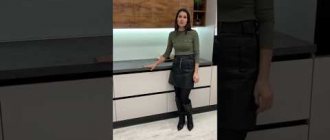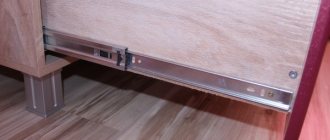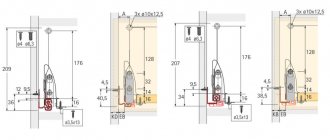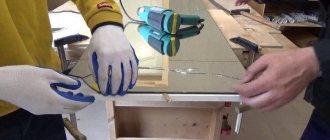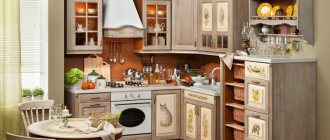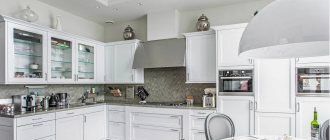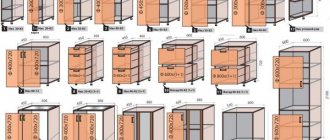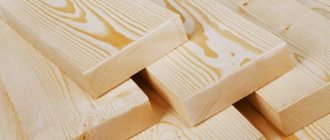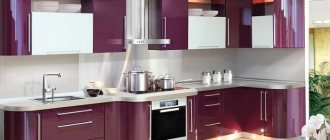The design for storing bottles in the kitchen cabinet extends on telescopic guides. Over time, a rather complex retractable system can fail. The reason for this, as a rule, is wear of the ball bearings. Removing the bottle holder will seem like an impossible operation.
Solving this problem is quite easy. You just need to know the design of the guide rails. The fact is that a special locking device in the form of a rotating plastic lever is installed inside the runners. Its tongue is visible inside the runners when the bottle holder-basket is removed from the cabinet as far as possible. The stopper levers of both guides are pressed down with a screwdriver or other suitable object. As a result, you can freely remove the bottle holder from the cabinet.
Then change the telescopic guides. Place the bottle holder in its place, securing it with screws. For a more complete understanding of this information, I recommend watching this video:
Designs with telescopic guides have become the most common solution for furniture, especially kitchen furniture. During operation, sometimes it becomes necessary to completely remove the furniture drawer from the cabinet. But you can’t do it just like that. Telescopic guides are the element that prevents the device from falling out during careless movement. This can be done without damaging the structure, with a minimum of knowledge and tools.
Types of products
The second name for the hardware option we are considering is ball guides, since the system moves on small balls, which ensure smooth running and durability of the structures. Let's figure out what product options are available, and then consider the model range presented on the market.
Main types
All telescopic options are divided according to the following characteristics:
- Possibility of disassembly . There are both collapsible and non-dismountable options; the second option is not suitable, since the element in it cannot be disassembled and it is difficult to remove such a box. But the vast majority of options on the market are collapsible, so there will be no problems with repairs.
The design consists of three main components shown in the diagram
- Number of steps . Depending on the extension length, structures are divided into two-section and multi-section. If everything is clear with the first option, then the second is much more complex in design, so you should disassemble it more carefully. But as for the installation and removal process, there is no fundamental difference; if you understand the topic, you will be able to service all types.
Multi-section options extend to a much greater distance than two-section options
- Presence of a closer . This element makes the use of furniture more convenient, because the drawers themselves are pressed to the end and become the way they need to be. Of course, models with a closer are noticeably more expensive than simple options without this element. What you choose in the end is up to you, both solutions are quite reliable, there is not much difference in quality.
The closer is a special plastic block on the outer edge of the structure
The most modern solution is guides that open the drawer when you press it; they are often called “Push to open,” which characterizes the principle of operation. The design is similar to the version with a closer, only it has an additional block that slightly pulls out the drawer when pressed.
The guides also differ in the degree of extension of the elements; there are three main options:
| Illustration | Description |
| Partial extension systems . A standard solution in which the element does not come out completely; a small part of it remains inside the housing, as shown in the photo. These are the cheapest products, which are similar in operating principle to standard roller products, although in terms of reliability they are significantly superior to this analogue. Their use is justified if you do not need full access to the internal cavity. | |
| Full extension designs . This type allows full access to the contents of the drawer, which is very convenient. Naturally, the reliability of the system is an order of magnitude higher than that of the first option, since it must withstand higher loads. Most often this is a multi-stage system, since it is impossible to ensure a large guide stroke using two units. | |
| Super full extension telescopic guides . This option allows the drawers to extend beyond the surface of the furniture façade, providing the best access to the contents. Such fittings are usually used in high-capacity elements; they can withstand high loads, but are also significantly more expensive than the analogues described above. |
Guide dimensions
On sale you can find different sizes of telescopic systems:
| Illustration | Description |
Height 17 mm. The most compact option with the following characteristics:
| |
Height 27-30 mm. This option is more reliable and has the following characteristics:
| |
| Height 35 mm . According to the main characteristics, this type of fittings resembles the type described above, so it makes no sense to list all its main features. The only significant difference is the permissible load, here it is already 20 kg. | |
Height 45 mm. The most common and popular solution today, which has a number of advantages:
|
Optimization of kitchen work
Now there are many different devices that make our lives easier. And those of them that were invented for the kitchen simply amaze the imagination. This includes an impressive range of household appliances - for all occasions, and mechanical devices, and modern fillings for cabinets. The bottle device we are considering belongs to the latter.
How to remove a drawer
Now let's figure out how to quickly remove the drawer in order to service the fittings or get things that have fallen behind the back wall. The work algorithm is described in detail below:
| Illustration | Description |
| We open the box we need . Everything is simple here - pull it towards you by the handle. | |
| Pulling out is done until it stops . The roll-out drawer extends until the guide stops it. We are interested in the end part of the element shown in the photo. | |
We find a plastic flag located inside the outer slot. Most often it is black, but it can have a different color, it doesn’t matter.
| |
| The antenna must be squeezed out. To do this, it is most convenient to use a thin flat screwdriver; you need to press on the element and slightly pull the box towards you, it should come out a few more centimeters. Please note that the flag can fall in one direction on both sides of the box, or it can move down on one side and up on the other. You just need to press on it - if it does not go down, then move it up and vice versa. You shouldn’t press too hard, as the plastic can break, which will make pulling out the element problematic. | |
| The antenna extends beyond the outer end of the body as shown in the photo . There is no need to pull it out further, as the fittings may be damaged. It is important that the elements are brought into the same position as shown in the photo on both sides of the box. | |
| The antennae should be pressed with your fingers . Most often they go down, but there may be an option when on one side the element needs to be raised up. Everything is simple here: we try to lower the flag, if it resists, then it needs to be raised, you should not press the plastic through the resistance, everything moves easily and can be pressed without problems. | |
The box is carefully pulled out. If you have removed all heavy objects from it in advance, then this process will not take much effort. It is important to pull the section, simultaneously pressing the flags on both sides, then it comes out easily and the likelihood of deformation and damage is minimal.
| |
| You need to pull until the middle section comes out of the element attached to the wall of the box . Everything is simple here, the main thing is not to distort the structure so as not to bend the guides. | |
| This is what the guide looks like after removing the drawer . Now you can clean up the internal compartment or repair and replace damaged parts. It is recommended to check the condition of the balls; they must be lubricated so that the system operates smoothly and with minimal wear. If the balls are dry, they can be lightly greased with thick grease; the cheapest grease will do, the main thing is to apply it a little so as not to stain the furniture. |
Types of closers for the kitchen
Closers for kitchen cabinets differ from each other in several ways .
Mechanism of action
According to the principle of operation, closers are divided into:
- Gas (pictured). The door closes freely until it touches the stem. The rod penetrates the dense gas environment of the sealed chamber, slowing down the movement of the door. Air or nitrogen is used as a filler. The average service life of gas devices is 5 years.
- Polymer . The mechanism of action is similar to the gas version. Instead of gas, a liquid polymer filler based on silicone is used. In terms of durability, they do not exceed gas ones.
- Oily . From the beginning of movement, the door or drawer immediately acts on a spring enclosed in a capsule with oil. The oil slowly flows into the adjacent chamber. The speed slows down and the entire closing cycle occurs smoothly. Oil shock absorbers are more durable, lasting up to 10 years. They are more expensive than gas or polymer ones.
Some tips on how to assemble a bottle holder
Hello dear friends.
Today we will talk about how the lower modules of the kitchen unit, which should have a built-in bottle holder, are assembled.
In this example, we will install this fittings in boxes 150mm wide.
What do you need to know when installing such fittings?
By the way, a small digression:
Personally, I always try to purchase such accessories with side mounting (that is, telescopic guides are attached to the side of the module).
There are also fittings with bottom fastening (when it is attached to the lower horizon of the module). In my opinion, it is more difficult to adjust the facade to which it is attached, since in the fixed position it has more play.
So, to begin with, we must measure the distance between the guides (using the holes for their fastening). After this, we prepare it for “installation” and remove those parts of the guides that should be attached to the sides of the module.
One more point:
In terms of height, it is better to place the bottle holder in the module in such a way that it is not attached to the lower part of the facade (thus, “provoking” play in its upper part), since problems with its adjustment may arise.
But, on the other hand, it should not be placed too high in the box, since an appropriate distance (for bottles) must be maintained between its upper tier (intended for the same bottles) and the body slats of the box.
In a word, its position in the box is adjusted “by eye” (since the boxes themselves can have different heights).
When the height position of the fittings is determined, we can mark the side of the box in accordance with the dimensions between the guides (which we measured).
After this, you need to determine the position of the bottle holder based on the depth of the box.
There are two nuances here:
- The front edge of the fittings should not be flush with the front edge of the box. The fact is that such fittings do not have clear geometric shapes (since they are made of rod and are easily deformed). Therefore, aligning its front part flush with the front edge of the box is impossible in principle. Therefore, it needs to be placed a little “deep” into the box (10-15mm).
- Its back part should also have a gap with the back wall of the module into which it is built in to ensure its normal functionality (as, for example, is always done with the design of drawers).
In order not to “bother too much” with these points, you can install two chipboard strips along the entire height of the installed bottle holder in front and behind the bottle holder located on the side part of the module.
When it is set, we use a tape measure to measure the distance from the front edge of the module to its front edge, along which we draw a line on the side part with a pencil.
This is a depth limiter, according to which the guides themselves are attached to the side. Mark the position of the fasteners and secure them.
Here you need to do the markings very carefully, since the guides are immediately attached rigidly (without the possibility of subsequent adjustment), and adjusting them in a box whose width is 150mm simply will not work.
After the guides are secured, insert the bottle holder into them.
At the end, we assemble the box itself (with a bottle holder attached to its right side).
By the way, such fittings are attached only to the right side of the module, and there is no possibility of making two modules, which, for example, should be located on both sides of some box (as in my case) with a “mirror” fastening.
At the end, the back wall is placed on the module and that’s it.
All that remains is to secure the facade (not a very pleasant procedure with such fittings).
Bottle holder for the kitchen: purpose, types and installation
It's no secret that kitchen furniture, first of all, should be functional and practical.
That is why, when designing it, various fittings are used, which are integrated into the drawers or stand alone, being part of the interior. A device such as a bottle holder for the kitchen deserves special attention. It is a structure made of metal rods, which is designed for the convenience of placing various utensils of the appropriate size in it.
Typical fittings for a kitchen wall, designed for small dishes and containers for various purposes
How to choose a bottle holder - a buyer's guide
How to choose a convenient and reliable bottle holder for the kitchen, a price review, photos of popular models of retractable cargo baskets and pro tips - here.
A bottle holder (cargo) is a retractable wire basket that is built into the upper or lower cabinets of a kitchen set. It extends thanks to telescopic guides, and its front side is covered with a furniture facade.
Quick navigation through the article:
- Review of prices and manufacturers
- Step 1. Select the bottle size
- Step 2: How many shelves do you need?
- Step 3. Choose a mounting method
- Step 4. Facade mounting angle
- Step 5. Additional options for convenience
- 6 useful tips from the pros
- If you have a washing machine in your kitchen, use a pull-out basket to store laundry detergents.
Benefits of using bottle storage structures
Having made the choice to purchase such a retractable basket, you will soon notice how much the frequency of cleaning associated with unfolding and placing jars in their places has been reduced. After all, when you take something out of a bottle, you take exactly the item that you needed.
The order in which everything else is located is not disturbed and, accordingly, is preserved much longer. Without a doubt, it is much more convenient to get out of an extended basket than from a cabinet located below, which is also too narrow. It is hardly possible to think of anything more appropriate for this.
What is the price
The cheapest Chinese-made bottle holders in Moscow online kitchen accessories stores cost from 2 thousand rubles. As a rule, these are simple models without closers with incomplete extension.
Cargo for the kitchen, made in Poland (Rejs) or Italy (Vibo), can be bought from 3 and 5 thousand rubles, respectively.
Narrow retractable systems from well-known brands from Germany or Austria (popular manufacturers - Blum, Hettich, Kessebohmer) are sold at a price of 10 thousand rubles. But you can find relatively inexpensive German-made models (Vault-Sagel), prices for which start at 6 thousand rubles.
The price of retractable baskets depends on the width of the facade, the number of shelves, and the presence of additional fittings.
Is it worth paying for the brand?
In more expensive cargo models, the price is paid not only for a big name, but also for a proven design, impeccable performance and long service life. Good fittings will last you 15 years, or even more.
There may be surprises when purchasing cheap accessories. For example, one of my friends decided to save money and was faced with the fact that bottles in a cheap basket fell every time when opened.
When ordering a kitchen in a showroom, keep in mind that the furniture manufacturer may add its own markup on fittings, and they may cost more than in online stores or construction hypermarkets.
Which bottle holders should you prefer - expensive or cheap?
As with the purchase of any product, the future owner will have to make a choice between savings and high quality. Seemingly identical goods, with seemingly unreasonably different prices, can differ greatly in quality.
There is always a difference between products of different price categories. It is in the material, in the execution, and in some technical features. All these points will certainly become noticeable during operation. The service life of cheap fittings is usually much shorter. But everyone makes their own choice.
- Your square meters will be used most efficiently, thereby saving you a lot of space.
- The bar counter acts as a space divider for the studio kitchen.
- The increased functionality of this kitchen set will make your life much more comfortable.
A bar counter is a kitchen accessory without which it is difficult to imagine the life of a modern young man. In addition, in the event of a breakdown, repairs can be made at home yourself, which makes them even more attractive for purchase.
You can install the stand near a window
6 more useful tips for choosing a convenient retractable bottle holder
- To make the bottles stand more stable and not touch each other, purchase special metal half-ring separators.
- When choosing a model, pay attention to the load for which it is designed. Narrow baskets, as a rule, can support up to 12 kg. Wider drawer systems can accommodate significantly more weight.
- More expensive fittings differ from cheaper ones not only in their design, but also in the quality of the shiny coating on the metal. The best option is if chrome plating is done by galvanic method. This coating lasts much longer, and its surface will be free of rust, scratches, chips and abrasions.
- Even if you decide to order a kitchen set with framed facades, if possible, it is still better to hide the pull-out sections behind smooth panels. It is easier to install fittings on flat facades.
- Fastening the basket to the facade is not always included in the kit. Sometimes you have to buy them additionally.
- Most baskets in the assortment of Moscow online stores are presented in chrome color. But if you ordered a kitchen set in a classic style with bronze fittings, try to find bottle holders in the same style. They look great with dark kitchens made of solid wood or MDF with oak, walnut or wenge veneer.
About kitchen sets with drawers: what cabinets should be in a kitchen set
A kitchen furniture set consists of several pieces, each of which contains drawers, baskets, cutting boards, etc.
Some of these elements are strictly functionally oriented. For example, the drawer of a cutting table already contains cells for storing knives, forks, spoons and other cutlery. Another drawer has slots for installing a roll of paper towels.
The main principle of using such accessories is convenience and comfort. Therefore, next to the built-in dishwasher there will definitely be a pull-out module for various plates. Near the kitchen stove there is a cabinet for storing pans and pots.
In addition to kitchen utensils, a large amount of food supplies, spices, detergents and other supplies are stored in the kitchen. For all this, the set is equipped with wall and floor cabinets and pencil cases. Each of them has niches for drawers.
Mounting methods
Before moving on to choosing a specific bottle holder model, you need to decide on the piece of furniture into which it will be built or the place where it will be installed. Most models involve a hidden method of placement - inside a box (compartment) of furniture items. However, the type of fastening may vary.
Today the following installation and fastening principles are commonly used:
- inside the compartment (box) on its side wall;
- lower fastening (rigid or retractable) to the bottom panel of the closed compartment;
- frontal - to the inner surface of the opening door.
For side and over-door mounting methods, the shelf depth is recommended within 150.0...200.0 millimeters. This will allow you not to overload the elements of furniture structures with excess weight from bottles, containers, and cans placed on the shelves.
Usually, when sold, a bottle holder comes with a set of necessary mounting hardware. In their absence, most products can be secured using self-tapping screws up to 10.0 millimeters long, designed for screwing into chipboard. Usually the structure is prefabricated.
An excellent addition to any kitchen set will be a two-tier bottle holder (article 13181525) from French designers (Leroy Merlin), which has representative offices in many large Russian cities. It is designed for installation on cabinet doors or hanging cabinets and is equipped with a closer. The basket and base are welded from chrome wire and thin rod.
The advantages of this model include:
- practicality, expressed in the possibility of installation in any already installed piece of kitchen furniture;
- accessibility of stored accessories, allowing you to easily get the necessary item;
- modern design, high ergonomics and ease of use, which is ensured by installing a door closer.
The installation method for models with bottom mounting depends on its type - movable or rigidly fixed. The greatest demand is for products mounted on roller bearings or skids. Typically, cargo of this type is installed in free-standing cabinets or floor cabinets.
Bottle holders installed on a separate roller cart, on the contrary, do not require separate space and can be installed inside any piece of furniture and even separately - outside pieces of furniture. However, when pulling out a basket mounted on a cart, a flat surface is required, so the prevalence of models of this design is low.
On a note!
When choosing the size of this kitchen accessory, the first place should be the requirements of functionality, practicality and the possibility of its placement or integration into pieces of furniture already installed in the kitchen.
Built-in
But it may be necessary to dismantle it during repairs. This is done like this:
- The door is removed. Typically, such lockers are designed in the form of a compartment, the doors in them are sliding on rollers, and the support can be either the lower or the upper one. To dismantle the door, you must carefully lift it so that the lower roller comes off the guides, then tilt it outward so that the upper roller comes off the rail. Then the door can simply be moved to the side.
- The shelves and sides of the internal sections are removed.
- If the remaining structure is light enough, it can be completely removed from the niche and pulled away (using rollers sold in hardware stores to move furniture or simply pieces of old thick wool fabric as a lining for a support so as not to scratch the floor). If it is still too heavy or you need to disassemble it alone, you need to continue dismantling.
- The back wall is removed. It is usually made of plywood or fiberboard, and is attached to small furniture nails. To remove it, carefully pry it up with the tip of a flat screwdriver or chisel, and separate it from the frame by gently pressing from the inside or lightly tapping it with a mallet.
- The frame itself is disassembled. It all depends on the design. If a tie was used on eccentrics, unscrew them; if the corners are used, unscrew the screws; if dowels are used, the elements are separated by gentle tapping.
- Upon completion of disassembly, the fittings are collected in a separate package, and the structural elements are marked so that when reassembling you know what is attached to what.
The video shows the process of disassembling a built-in wardrobe:
Required number of shelves
Often, narrow retractable cargo has two shelves.
The lower one is used to accommodate tall bottles and containers, and the upper one is adapted for low containers and cans.
Do you plan to use this basket to store various canned goods, other supplies, a large number of small jars and containers of spices? Then the most correct solution would be to use three-tier models. Although there are also cases when just one tier is enough. It is better to think in advance what you will store inside and in what quantity.
Many people make the mistake of buying a model that is too compact, which is why they are then unable to fit the required number of items inside. The bottle holder becomes overfilled and may not be able to withstand the load.
High-quality fittings have the function of adjusting the height of the shelves.
The instructions are not difficult to figure out how to remove or change the height of the tier.
Dimensions
The sizes of bottle holders for the kitchen offered by manufacturers represent a whole range. Their width varies from 100 mm to 450 mm, in increments of 50 mm. Based on this, we can conclude that there is a place for this useful basket in any kitchen. It is not surprising that this type of fittings provides quite a wide range of opportunities for planning a kitchen interior.
Small design for storing spice jars
In small rooms, narrow systems with side mounting are most preferable. In sets for them, it is common to use bottle holders for the kitchen with a width of 150 mm, and the most common size is 200 mm.
Design size - 200 mm
When planning a set of standard cabinets for furniture, there is often a narrow space left in which, if anything can be built in, it is bottle holders for the kitchen 100mm wide.
Size – 100 mm width
Thus, you can implement this device in cabinets of completely different widths.
Material of manufacture
Before installing a bottle holder in your kitchen, you need to think carefully. Consider which material would be best suited for these tasks.
The kitchen is associated with constant high humidity and temperature changes. Because of this, it is not worth using materials that have low resistance to these influences.
On sale there are cargo made of wood, metal, chipboard, MDF and plastic. If the furniture in the kitchen is wooden, then it is better to take cargo based on wood. At the same time, it would be better if the shelves themselves were metal.
Don't forget to make sure that the shelves of the bottle holder are covered with protective materials to prevent rust. Aluminum and chrome-plated products perform better in this component.
If you are interested in making a bottle holder with your own hands, this material describes the process in sufficient detail. Or leave your feedback. And soon we will separately tell you about all the nuances and subtleties of cargo manufacturing.
Assembling furniture with your own hands or how to save a tidy sum
Among the most common options for bottle holders are cargo with a width of 100, 200 and 150 millimeters. If you take a narrower model, you won’t be able to place larger bottles with the same oil inside. There are also very wide models of 400 mm. In fact, these are already shelves for storing kitchen utensils, food and other utensils. Therefore, buyers usually choose in the range from 100 to 250 mm.
But since everyone has different requirements and tasks that the bottle holder faces, then when choosing sizes, start from them.


